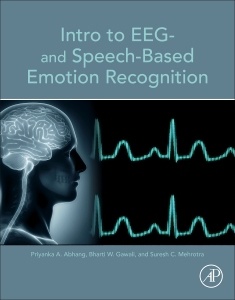Introduction to EEG- and Speech-Based Emotion Recognition
Auteurs : Abhang Priyanka A., Gawali Bharti W., Mehrotra Suresh C.

Introduction to EEG- and Speech-Based Emotion Recognition Methods examines the background, methods, and utility of using electroencephalograms (EEGs) to detect and recognize different emotions. By incorporating these methods in brain-computer interface (BCI), we can achieve more natural, efficient communication between humans and computers. This book discusses how emotional states can be recognized in EEG images, and how this is useful for BCI applications. EEG and speech processing methods are explored, as are the technological basics of how to operate and record EEGs. Finally, the authors include information on EEG-based emotion recognition, classification, and a proposed EEG/speech fusion method for how to most accurately detect emotional states in EEG recordings.
1. Introduction to Emotion, Electroencephalography and Speech Processing
2. Technological Basics of EEG Recording and Operation of Apparatus
3. Technical Aspects of Brain Rhythms and Speech Parameters
4. Time and Frequency Analysis
5. Emotion Recognition
6. Multimodal Emotion Recognition
7. Proposed EEG – Speech Based Emotion Recognition System: A CASE STUDY
8. BCI and its Applications
Neuroscientists, computational neuroscientists, neurologists, engineers, BCI/EEG researchers, graduate students/post-docs in biological and biomedical sciences
Dr. Bharti W. Gawali has completed M. Sc. Computer science (1998), Ph. D. (2007), SET (2003). She is presently working as a Professor in Department of Computer Science and Information Technology, Dr. Babasaheb Ambedkar Marathwada University, Aurangabad (MS), India. More than 60 research papers in reputed journals. She has successfully completed three major research projects on BCI and Speech Processing. She is associated with various professional bodies like FIETE, FIAENG and FISCA etc. Her field of specification are Data compression, Speech and Speaker Recognition, Human computer Interaction, Emotion Recognition, Signature Recognition, Brain Computer Interface, GIS and remote sensing, Medical Image Processing.
Dr. Suresh Chandra Mehrotra has completed M. Sc. Physics (1970), Ph.D. (1975), Post Doctorate (Welch Foundation Fellow) (1974-75). Now his designation as Srinivasa Ramanujan Geospatial Chair Professor. He is recipient of Career Award, FOM, Alexander Von Humboldt Fellowship, F.N.A.Sc. He is a fellow and life member of Indian Physics Association (IPA), Indian Laser Association (ILA), Indian Science Congress Association, and IETE. He has also been awarded with Best Teacher Award from Maharashtra (MS) state. More than 239 research papers are published in reputed journals and conferences, and 5 books to his credit. He has organized 7 conferences/workshop and seminar as Chairman/Convener. He has successfully completed Eight Research Project. His fields of specializations are Microwaves Interaction with Matter, Time Domain Spectroscopy Pattern Recognition, Brain Compute
- Provides detailed insight on the science of emotion and the brain signals underlying this phenomenon
- Examines emotions as a multimodal entity, utilizing a bimodal emotion recognition system of EEG and speech data
- Details the implementation of techniques used for acquiring as well as analyzing EEG and speech signals for emotion recognition
Date de parution : 03-2016
Ouvrage de 198 p.
19x23.3 cm
Thèmes d’Introduction to EEG- and Speech-Based Emotion Recognition :
Mots-clés :
Active electrodes; Active region images; Active regions; Alpha; Arousal; Assistive technology; BCI; Beta; Bimodal; Brain waves; Brain; Computerized Speech Laboratory (CSL)Electroencephalography (EEG) machine; Correlation; Delta; ECoG; Edge detection; EEG images; EEG signals; EEG speech; Emotion recognition; Emotive; Energy; Facial expression; Fourier transformation; Gabor transformation; Gamma; Gestures; Happy; Intensity; Lobes; Modalities; Multimodal; Object masking; Pitch; Prosodic features; Relaxed; RMS EEG 32-channel machine; Sad; Signal processing; Sliding window; Speech mechanisms; Speech processing; Speech production; Speech signals; Speech; Theta; Uncertainty principle; Unimodal; User interfaces; Valance; Wavelet transformation



